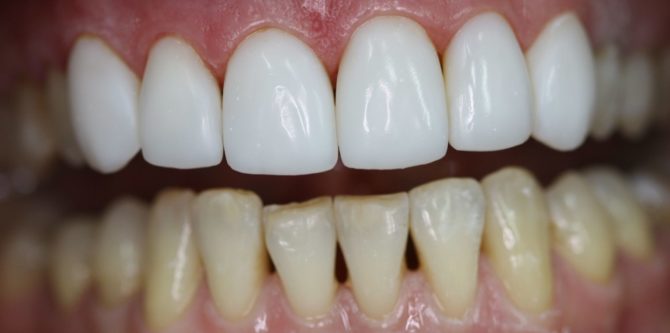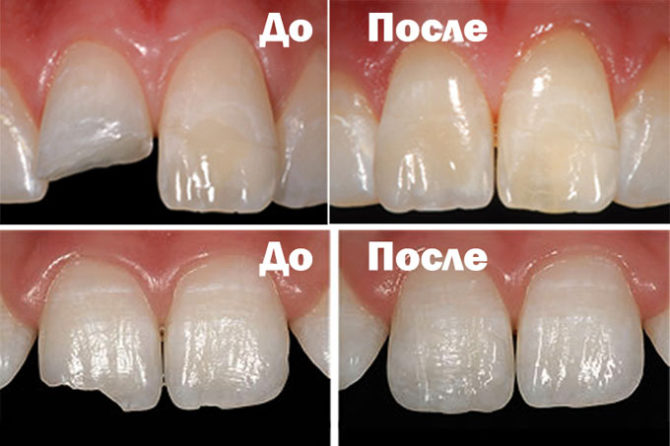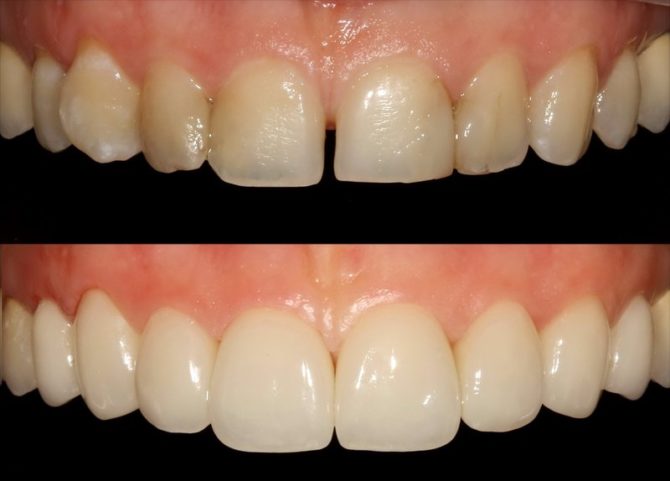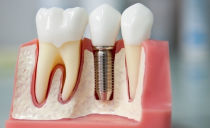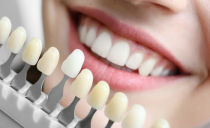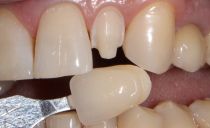Methods and stages of artistic and aesthetic restoration of front teeth
Due to tooth decay, not only the aesthetics of the smile suffers, but also the functioning of the digestive system, since a person cannot fully chew food. In the affected areas of the tooth, many bacteria accumulate, which further exacerbates the situation. Therefore, with any damage to the teeth, it is very important to restore their appearance and shape, especially when it comes to incisors and fangs visible to others.
In modern dentistry clinics different methods of restoration of the front teeth are applied - from the use of filling material to prosthetics with veneers and lumineers.
Content
The essence and types of aesthetic restoration
Aesthetic restoration is not only restoration of the functions of the teeth, but also giving them the necessary shape and desired color. These properties of the dentition can be lost due to injuries, diseases or due to congenital defects in the development of the dentition.
Modern dentistry carry out such a perfect restoration of teeth that they are really able to ensure the creation of a “Hollywood smile”. You can do this using two methods:
- Direct artistic restoration of the anterior teeth, performed with the help of filling composite materials, which are applied directly to the tooth.
- Indirect aesthetic restoration of the anterior teeth, performed with the help of overlays, which are modeled and created before installation on the tooth.
The choice of technique depends not only on the initial state of the dentition, but also on the equipment of the dentistry that the patient is contacting, as well as on his financial capabilities.
Direct restoration of teeth - full and partial
Indications for restoration of anterior teeth with filling material are diverse. There are methods of complete restoration for the restoration of severely damaged teeth, in which an artificial crown is created from scratch. And there are techniques for eliminating small defects - chips, cracks.
High-quality performance of work, the availability of the latest equipment and the correct selection of the shade of filling material can improve the condition of the dentition tenfold. Modern light-polymer solutions really mimic the natural surface of the crown, and it is possible to restore the tooth with filling material in one visit. But despite these advantages, the direct restoration has the disadvantages:
- It is difficult to find an experienced dentist who has high-quality equipment, materials and knows how to use them correctly. Often, after performing an artistic restoration, patients turn to another dentistry to remove fillings that are very different from the shade of their teeth or quickly deteriorate due to a violation of the installation technology.
- Even with the perfect shade of the materials used, they fade over time, so the aesthetics remain for a short time. And some solutions are not at all capable of forming a layer similar to the surface of a natural tooth in terms of translucency.
After direct restoration, the tooth becomes more fragile. Most fragility of dental tissue increases with depulpation, so the dentition after such procedures must be protected with special diligence.
Stages of filling
During the full or partial artistic restoration of the tooth, the patient will have to go through the following stages:
- Examination of the oral cavity for the presence of inflammation or dental deposits. The inflammatory process needs to be cured, and tartar should be removed before filling.
- On a special scale, the shade of filling material is selected, which should fully correspond to the color of the natural tooth tissues, otherwise the restoration site will differ markedly and “catch the eye”.
- If necessary, make an anesthetic injection.
- The dentist cleans all cavities affected by caries, eliminates the destroyed enamel.
- It is necessary to provide a dry environment around the filled tooth. Previously, this was done with cotton balls, absorbing saliva, now - cofferdam - a latex plate stretched over the teeth. It completely protects the manipulation site from saliva. If moisture gets under the filling, the material will not adhere to the tooth and will fall out, or caries will develop along the edges of the filling.
- If the tooth is more than half destroyed, it is preliminarily depulped and a pin is installed on which the seal will be held. If filling material is applied without a pin, it may fall out when the load is increased.
- The dentist applies the filling material in layers. The layered method of applying the material is used to create the necessary shade and translucency to maximize the imitation of the natural surface of the crown.
- The seal is polished and polished, eliminating irregularities that interfere with the bite.
Indirect Restoration
The use of linings in the form of veneers or lumineers is becoming more and more popular, even despite the fact that high-quality microprostheses are not cheap. Ceramic-metal, zirconium and ceramic veneers are known.
Compared to ceramic or cermet overlays, composite filling materials look worse and serve less, but cost less. Ceramic veneers and lumineers are the most expensive linings, but they look completely aesthetically pleasing and last a very long time. They are often installed on the front teeth, they are almost never used to restore the back.
Even strong lining on the teeth is a reason for special care. Teeth restored in this way, you can not bite nuts, nails, click seeds. After the final installation, the veneer cannot be adjusted or removed; if it is damaged or broken, an artificial crown must be placed.
Stages of indirect restoration
Indirect aesthetic restoration of anterior teeth takes more time than direct, as it takes several days to make ceramic or sintered metal veneers. The process consists of the following steps:
- Examination of the mouth and rehabilitation, as in the case of composite restoration.
- Determination of the shade of the material used.
- Anesthetic injection.
- Enamel turning for the subsequent installation of the lining. The thicker the veneer, the larger the enamel layer.may need to be depulped. For thin lumineers, minimal turning is necessary, or it is not done at all.
- Taking a mold from the restored tooth and sending it to the laboratory for modeling the veneer.
- Installation of temporary plates on a turned tooth (until the next visit to dentistry, while a permanent patch is made)
- At the next visit to the dentist, the finished veneer is tried on, if the patient does not feel any discomfort, the pad is fixed to the solution completely.
Contraindications for restoration
Some patients have to refuse tooth restoration or postpone it for some time. Contraindications for direct or indirect tooth restoration are:
- Dental infectious diseases.
- Acute infectious processes in any internal organ.
- Pregnancy: in the second trimester, restoration is allowed, but only if the pregnancy proceeds without complications.
- The tendency to gnash teeth at night.
- Dangerous occupations or hobbies that often lead to tooth injuries.
Other ways to restore teeth
If, for whatever reason, patients cannot be restored with a direct or indirect aesthetic restoration, they can put an artificial crown. Today, various materials are available for their manufacture. Compared to the metal crowns that were used before, modern ceramic-metal prostheses look very aesthetically pleasing and are not inferior in appearance even to veneers.
 Crowns make it possible to restore teeth that are completely or almost completely destroyed, and allow you to return the full chewing ability of the dentition. According to these indicators, artificial crowns are preferable to tooth restoration performed using the described methods, but the procedure for their installation is more complicated. Before the installation of the crown, the tooth is turned, a depulpation may be required, and pins are necessary to increase the holding strength of the artificial structure.
Crowns make it possible to restore teeth that are completely or almost completely destroyed, and allow you to return the full chewing ability of the dentition. According to these indicators, artificial crowns are preferable to tooth restoration performed using the described methods, but the procedure for their installation is more complicated. Before the installation of the crown, the tooth is turned, a depulpation may be required, and pins are necessary to increase the holding strength of the artificial structure.
If several teeth located nearby are damaged or removed, restoration based on implants will help restore the aesthetics of a smile. This is an expensive and complicated procedure that involves the unpleasant steps of introducing pins. But the installed prostheses are made of high-quality materials, have an excellent appearance and serve with careful care for more than 20 years.
If a person has lost a tooth due to illness, injury or improper care, this is not a sentence to a life-long complex due to an unaesthetic smile. Dentistry has a mass of the latest techniques of aesthetic restoration of teeth that can bring the look of a smile to the ideal. Moreover, the strength and quality of materials are constantly improving thanks to new approaches in their manufacture.
Care must be taken in choosing a dentist so as not to fall into the hands of an inexperienced doctor. If the restoration is carried out in compliance with all the rules, and a person carefully cares for the oral cavity, it is possible to preserve the beauty of the teeth for three decades.

